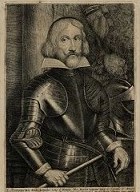Paul-Bernard de Fontaines: Difference between revisions
mNo edit summary |
Oreo Priest (talk | contribs) m fmt |
||
| Line 53: | Line 53: | ||
When the twelve-year armistice ended in 1621, he built fortresses from Knokke to Lapscheure, later known as the [[Fontaine line]]. In 1631, as commander of the Spanish troops, he broke through the [[siege of Bruges]] by [[Frederick Henry, Prince of Orange]]. In the course of his career, Fontaine appeared more as an efficient administrator than as a military strategist. |
When the twelve-year armistice ended in 1621, he built fortresses from Knokke to Lapscheure, later known as the [[Fontaine line]]. In 1631, as commander of the Spanish troops, he broke through the [[siege of Bruges]] by [[Frederick Henry, Prince of Orange]]. In the course of his career, Fontaine appeared more as an efficient administrator than as a military strategist. |
||
In 1638, he was appointed the [[Maestre de campo]] (Commander of the Infantry). At this time, he was already chronically ill and barely capable of military service.<ref name=road>{{Cite book|url=https://books.google.com/books?id=737c9ylAfswC&pg=PA283&lpg=PA283&dq=Paul-Bernard+de+Fontaine&source=bl&ots=DJeAzwGJU0&sig=-29z-REn4Daf2LrQyY6X_3yhruA&hl=en&sa=X&ved=0ahUKEwiF857Uz4zXAhVR0mMKHUBMCkE4ChDoAQglMAA#v=onepage&q=Paul-Bernard%20de%20Fontaine&f=false|title=The Road to Rocroi: Class, Culture and Command in the Spanish Army of Flanders, 1567-1659|last=León|first=Fernando González de|date=2009|publisher=BRILL|isbn=9004170820|language=en}}</ref> At the [[battle of Rocroi]] in 1643, he commanded his [[Tercio]]s from a sedan chair before he fell and was later buried in the monastery church of the Friars Minor Brotherhood.<ref name=road></ref>(The monastery and church were later destroyed during the French occupation.) |
In 1638, he was appointed the [[Maestre de campo]] (Commander of the Infantry). At this time, he was already chronically ill and barely capable of military service.<ref name=road>{{Cite book|url=https://books.google.com/books?id=737c9ylAfswC&pg=PA283&lpg=PA283&dq=Paul-Bernard+de+Fontaine&source=bl&ots=DJeAzwGJU0&sig=-29z-REn4Daf2LrQyY6X_3yhruA&hl=en&sa=X&ved=0ahUKEwiF857Uz4zXAhVR0mMKHUBMCkE4ChDoAQglMAA#v=onepage&q=Paul-Bernard%20de%20Fontaine&f=false|title=The Road to Rocroi: Class, Culture and Command in the Spanish Army of Flanders, 1567-1659|last=León|first=Fernando González de|date=2009|publisher=BRILL|isbn=9004170820|language=en}}</ref> At the [[battle of Rocroi]] in 1643, he commanded his [[Tercio]]s from a sedan chair before he fell and was later buried in the monastery church of the Friars Minor Brotherhood.<ref name=road></ref> (The monastery and church were later destroyed during the French occupation.) |
||
== References == |
== References == |
||
Revision as of 08:59, 25 July 2018
This article relies largely or entirely on a single source. (October 2017) |
This article needs additional or more specific categories. (October 2017) |
Paul-Bernard de Fontaines | |
|---|---|
 | |
| Born | 1566 |
| Died | 19 May 1643 |
| Allegiance | Spain |
| Service/ | Infantry |
| Years of service | 1596-1643 |
| Rank | Captain of the infantry; captain of the cavalry; Maestre de campo |
Paul-Bernard de Fontaines (1566 Lorraine - 19 May 1643 Rocroi), also known as Comtefontaine, Conde Fontana or Fuentes, was commander of the Spanish infantry during the Eighty Years War. He was Vogt of Bruges and governor of Damme. He participated in the battles around Hulst, Kallo and Antwerp.
Life
Paul-Bernard de Fontaine was the son of Francisco de Fontaine, Lord of Cierges, rider-chief, governor of Stenay, administrator of the Duke of Lorraine, and Suzanne d'Urre. Both died before Fontaine had finished his first year. His maternal grandfather, Jean d'Urre, master of Thessières, took care of him until, in 1584, he resigned his guardianship, he was 87 years old and died two years later, and gave his oldest son Charles.

In 1636, together with his wife, Anna de Ragicourt, he founded a chapel and almshouse in the Zwarteleertouwersstraat in Bruges for twelve impoverished soldiers. His coat of arms is placed over the door in the side wall. The building was used until 1914 according to the foundations and is now a monument. At the St. Walburga church at Damme he donated a main altar bearing his coat of arms.
In 1596, he joined the King of Spain as a volunteer, and subsequently made a military career. In 1597, he was Captain of the infantry; in 1604, captain of the cavalry, in 1611, he became military commander in Flanders. When the twelve-year armistice ended in 1621, he built fortresses from Knokke to Lapscheure, later known as the Fontaine line. In 1631, as commander of the Spanish troops, he broke through the siege of Bruges by Frederick Henry, Prince of Orange. In the course of his career, Fontaine appeared more as an efficient administrator than as a military strategist.
In 1638, he was appointed the Maestre de campo (Commander of the Infantry). At this time, he was already chronically ill and barely capable of military service.[1] At the battle of Rocroi in 1643, he commanded his Tercios from a sedan chair before he fell and was later buried in the monastery church of the Friars Minor Brotherhood.[1] (The monastery and church were later destroyed during the French occupation.)
References
- ^ a b León, Fernando González de (2009). The Road to Rocroi: Class, Culture and Command in the Spanish Army of Flanders, 1567-1659. BRILL. ISBN 9004170820.
Further reading
- Guyot, Ch (1886). Paul-Bernard, Comte de Fontaine, mort à Rocroi en 1643 (in French).
- "Letter to the Editor". The Edinburgh Review. 1869. Retrieved 2018-05-18.
![]() This article incorporates text available under the CC BY-SA 3.0 license.
This article incorporates text available under the CC BY-SA 3.0 license.
